In the late 1990s, the internet grew exponentially to become an enormous engine for technological progress and economic disruption.
The existing telecommunications infrastructure was designed to carry voice and television signals—not data packets. The system needed billions of dollars in fiber and copper to support the tidal wave. Telecom entrepreneurs, incumbent executives and capital markets were eager to invest capital and ride the boom.
In this episode, we tell the parallel rise (and unraveling) of two giants who tried to wire the future from opposite ends of the network.
On one side: John Malone, the genius capital allocator behind TCI, stitching together last-mile cable systems and striking the blockbuster sale to AT&T in 1999 as the industry chased an “integrated provider” vision after the ’96 Telecom Act.
On the other: Bernie Ebbers of WorldCom, an acquisition machine that vaulted from discount long-distance reseller to national carrier—fueled by a once-accurate-later-obsolete statistic implying “internet traffic doubles every 100 days,” a meme born at UUNet and soon echoed by CEOs, analysts, and even the U.S. Commerce Department.
We follow the capex arms race, Williams’ ingenious move to pull fiber through abandoned pipelines, the strategic missteps at AT&T, and the line-cost KPIs that nudged WorldCom across the line from pressure to fraud.
Along the way, we draw out lessons for investors and operators that resonate in today’s AI boom.
Chapters
(01:15) The meme that sparked the boom
(04:00) Market structure for telecom in the 1990s
(10:01) Huge capital expenses
(11:16) Opportunity space for entrepreneurs
(12:59) Introducing Bernie Ebbers and John Malone
(18:02) The invention of EBITDA
(20:18) Everything changes in ‘95 and ‘96
(26:50) LDDS becomes WorldCom—a top long-distance carrier
(31:20) TCI becomes a top cable company
(35:14) Prices down in long-distance telephone & last-mile assets become very valuable
(37:24) TCI acquired by AT&T
(39:10) Contrasting dot com vs telecom financing
(43:23) AT&T-TCI merger challenges & WorldCom earnings down
(52:02) Aftermath for John Malone and Bernie Ebbers
(55:53) Lessons learned and applications to today
References
Cable Cowboy: John Malone and the Rise of the Modern Cable Business (link)
Born to Be Wired: Lessons from a Lifetime Transforming Television, Wiring America for the Internet, and Growing Formula One, Discovery, Sirius XM, and the Atlanta Braves by John Malone (link)
Extraordinary Circumstances: The Journey of a Corporate Whistleblower by Cynthia Cooper (link)
Boom and Bust in Telecommunications by the Federal Reserve Bank of Richmond (link)
This is a public episode. If you would like to discuss this with other subscribers or get access to bonus episodes, visit www.backtestpodcast.com
 Oct 30 202559 min
Oct 30 202559 min 1 h
1 h 1 h et 1 min
1 h et 1 min 58 min
58 min Aug 21 202557 min
Aug 21 202557 min 59 min
59 min 58 min
58 min 1 h et 41 min
1 h et 41 min
